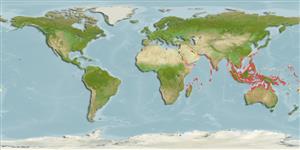Common names from other countries
>
Acanthuriformes (Surgeonfishes) >
Siganidae (Rabbitfishes)
Etymology: Siganus: Latin, siganus = a fish, rabbit fish; by the similarity of the nose (Ref. 45335).
More on author: Linnaeus.
Environment: milieu / climate zone / depth range / distribution range
Sinh thái học
Biển; Thuộc về nước lợ Cùng sống ở rạn san hô; Ở đại duơng, biển (Ref. 51243); Mức độ sâu 0 - 20 m (Ref. 90102), usually 2 - 20 m (Ref. 27115). Tropical; 25°C - 28°C (Ref. 27115); 30°N - 20°S
Indo-Pacific: Persian Gulf, Gulf of Oman, Pakistan, India, Sri Lanka, Burma, Andaman Islands, Thailand, Viet Nam, southern China, Malaysia, Indonesia, Philippines, Australia, New Guinea, Vanuatu and New Caledonia. Records for the Ryukyu and Ogasawara Islands could be based on strays (Ref. 9813).
Bộ gần gũi / Khối lượng (Trọng lượng) / Age
Maturity: Lm ? range ? - ? cm
Max length : 53.0 cm TL con đực/không giới tính; (Ref. 9710); common length : 30.0 cm TL con đực/không giới tính; (Ref. 9813)
Các tia vây lưng cứng (tổng cộng) : 13; Các vây lưng mềm (tổng cộng) : 10; Tia cứng vây hậu môn: 7; Tia mềm vây hậu môn: 9; Động vật có xương sống: 13. Body bronze above, white on belly and thorax; iris light brown; pectoral fins hyaline, pelvic fins white. Slender and pungent dorsal spines; anal spines stout. Preopercular angle 78°-92°. Strong scales cover cheeks. Midline of thorax scaled but not pelvic ridges. Broad-based triangular flap of anterior nostril reaching half way to posterior nostril in juveniles, reducing to a small crescent with age.
Occurs in small schools of up to 10 individuals or so, in shallow coastal waters, brackish lagoons and rocky or coral reefs. Feeds on algae attached to the substrate and on floating algal fragments. Found resting in midwater at depths of 2 to 6 m when not feeding. Marketed fresh (Ref. 9813, 48637). Maximum depth from Ref. 027115.
Life cycle and mating behavior
Maturities | Sự tái sinh sản | Spawnings | Egg(s) | Fecundities | Ấu trùng
Woodland, D.J., 1990. Revision of the fish family Siganidae with descriptions of two new species and comments on distribution and biology. Indo-Pac. Fish. (19):136 p. (Ref. 1419)
IUCN Red List Status (Ref. 130435)
CITES (Ref. 128078)
Not Evaluated
Human uses
Các nghề cá: Tính thương mại; Bể nuôi cá: Tính thương mại
Các công cụ
Special reports
Download XML
Các nguồn internet
Estimates based on models
Preferred temperature (Ref.
115969): 25.5 - 29.1, mean 28.3 (based on 1152 cells).
Phylogenetic diversity index (Ref.
82804): PD
50 = 0.5000 [Uniqueness, from 0.5 = low to 2.0 = high].
Bayesian length-weight: a=0.01445 (0.00904 - 0.02311), b=3.06 (2.93 - 3.19), in cm Total Length, based on LWR estimates for this species & Genus-body shape (Ref.
93245).
Mức dinh dưỡng (Ref.
69278): 2.4 ±0.08 se; based on food items.
Thích nghi nhanh (Ref.
120179): Trung bình, thời gian nhân đôi của chủng quần tối thiểu là 1.4 - 4.4 năm (Preliminary K or Fecundity.).
Fishing Vulnerability (Ref.
59153): Moderate vulnerability (41 of 100).
